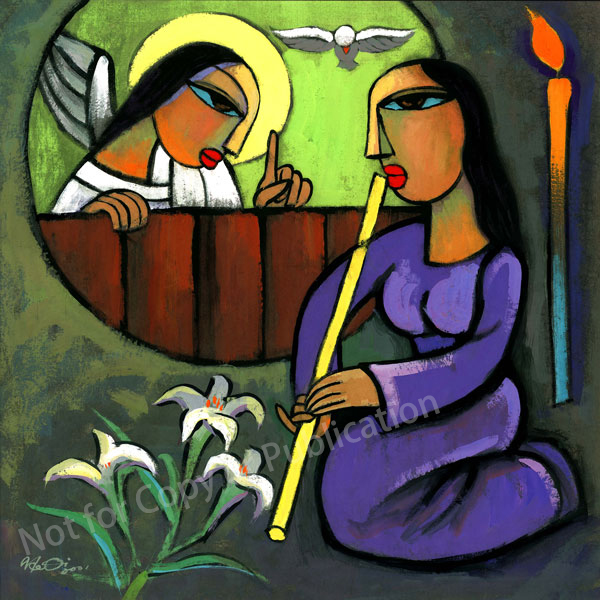
This is a contemporary tempera/gouache on leather painting by an unknown Ethiopian artist. Source: Sacred Art Pilgrim website .

This is a contemporary tempera/gouache on leather painting by an unknown Ethiopian artist. Source: Sacred Art Pilgrim website .
The Hebrew, Greek, and Latin that is sometimes translated as “ark of the covenant” in English (other English options: “pact chest” [translation by John Goldingay, 2018] or “Coffer of the Covenant” [translation by Everett Fox, 1995]) is translated in various ways:
Following is reverse applique stitching (“mola”) by an unknown Guna artist depicting the ark:

Source: Sacred Art Pilgrim website .
In American Sign Language it is translated with a sign that combines “box” and the wings of the cherubim on top of the ark (see Exod 25:18 and following). (Source: RuthAnna Spooner, Ron Lawer)
“Ark of the covenant” in American Sign Language, source: Deaf Harbor
See also cherub and tabernacle (noun).

This is a contemporary tempera/gouache on leather painting by an unknown Ethiopian artist. Source: Sacred Art Pilgrim website .
Following is a painting by Chen Yuandu 陳緣督 (1902–1967):

Housed in the Société des Auxiliaires des Missions Collection – Whitworth University.
Image taken from Chinese Christian Posters . For more information on the “Ars Sacra Pekinensis” school of art, see this article , for other artworks of that school in TIPs, see here.

This is a contemporary tempera/gouache on leather painting by an unknown Ethiopian artist. Source: Sacred Art Pilgrim website .

This is a reverse applique stitching (“mola”) by an unknown Guna artist, depicting this verse.
Source: Sacred Art Pilgrim website .
Following is a contemporary Ukrainian Orthodox icon of the confession of Thomas by Ulyana Tomkevych.

Orthodox Icons are not drawings or creations of imagination. They are in fact writings of things not of this world. Icons can represent our Lord Jesus Christ, the Virgin Mary, and the Saints. They can also represent the Holy Trinity, Angels, the Heavenly hosts, and even events. Orthodox icons, unlike Western pictures, change the perspective and form of the image so that it is not naturalistic. This is done so that we can look beyond appearances of the world, and instead look to the spiritual truth of the holy person or event. (Source )
See also Thomas and Thomas with the risen Christ (image).

Image taken from the Wiedmann Bible. For more information about the images and ways to adopt them, see here . For other images of Willy Wiedmann paintings in TIPs, see here.
Following is a contemporary tempera / gouache on leather painting by an unknown Ethiopian artist:

Source: Sacred Art Pilgrim website .
Following is a painting (“Annunciation”) by He Qi:

Image taken from He Qi Art . For purchasing prints of this and other artworks by He Qi go to heqiart.com . For other images of He Qi art works in TIPs, see here.
Following is a contemporary Ukrainian Orthodox icon of Christ as the grapevine by Ulyana Tomkevych.

Orthodox Icons are not drawings or creations of imagination. They are in fact writings of things not of this world. Icons can represent our Lord Jesus Christ, the Virgin Mary, and the Saints. They can also represent the Holy Trinity, Angels, the Heavenly hosts, and even events. Orthodox icons, unlike Western pictures, change the perspective and form of the image so that it is not naturalistic. This is done so that we can look beyond appearances of the world, and instead look to the spiritual truth of the holy person or event. (Source )